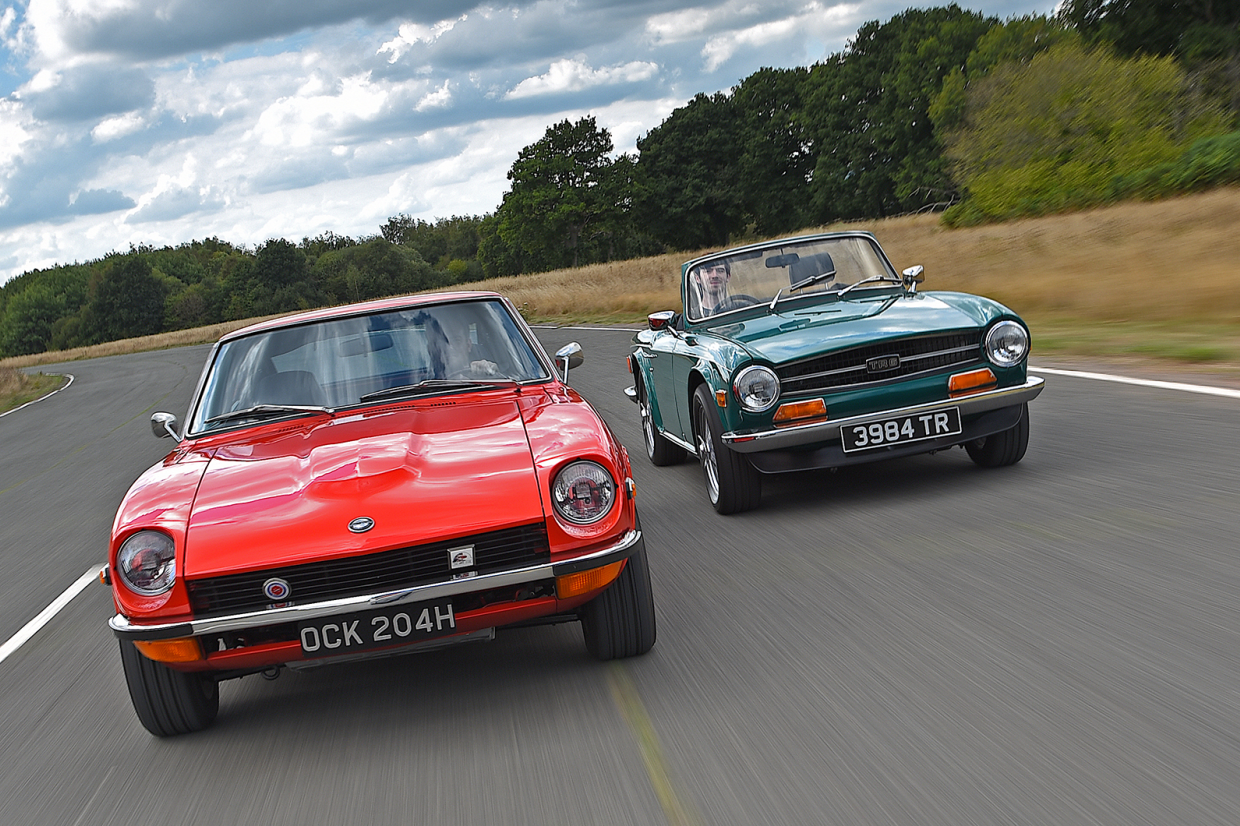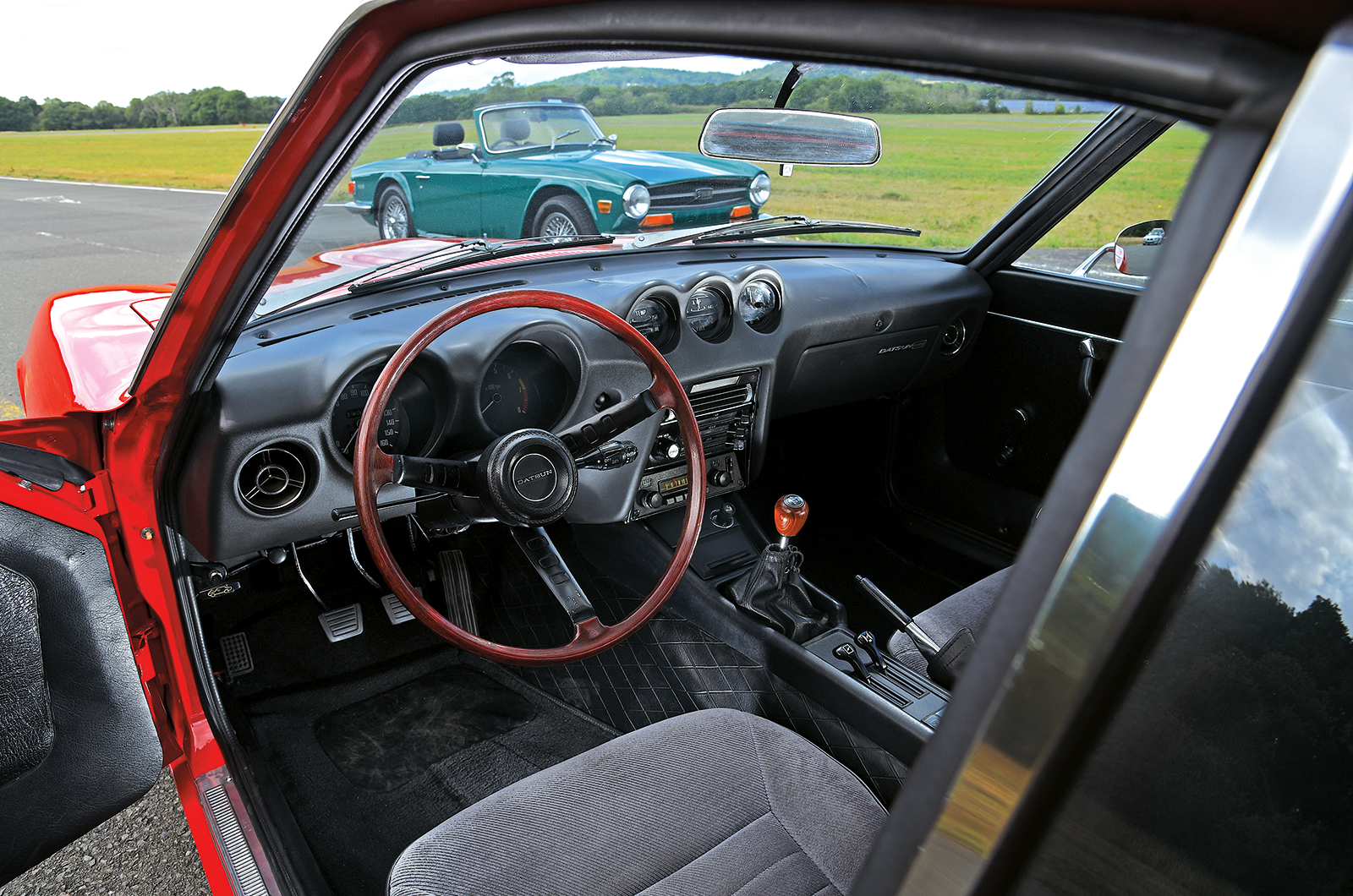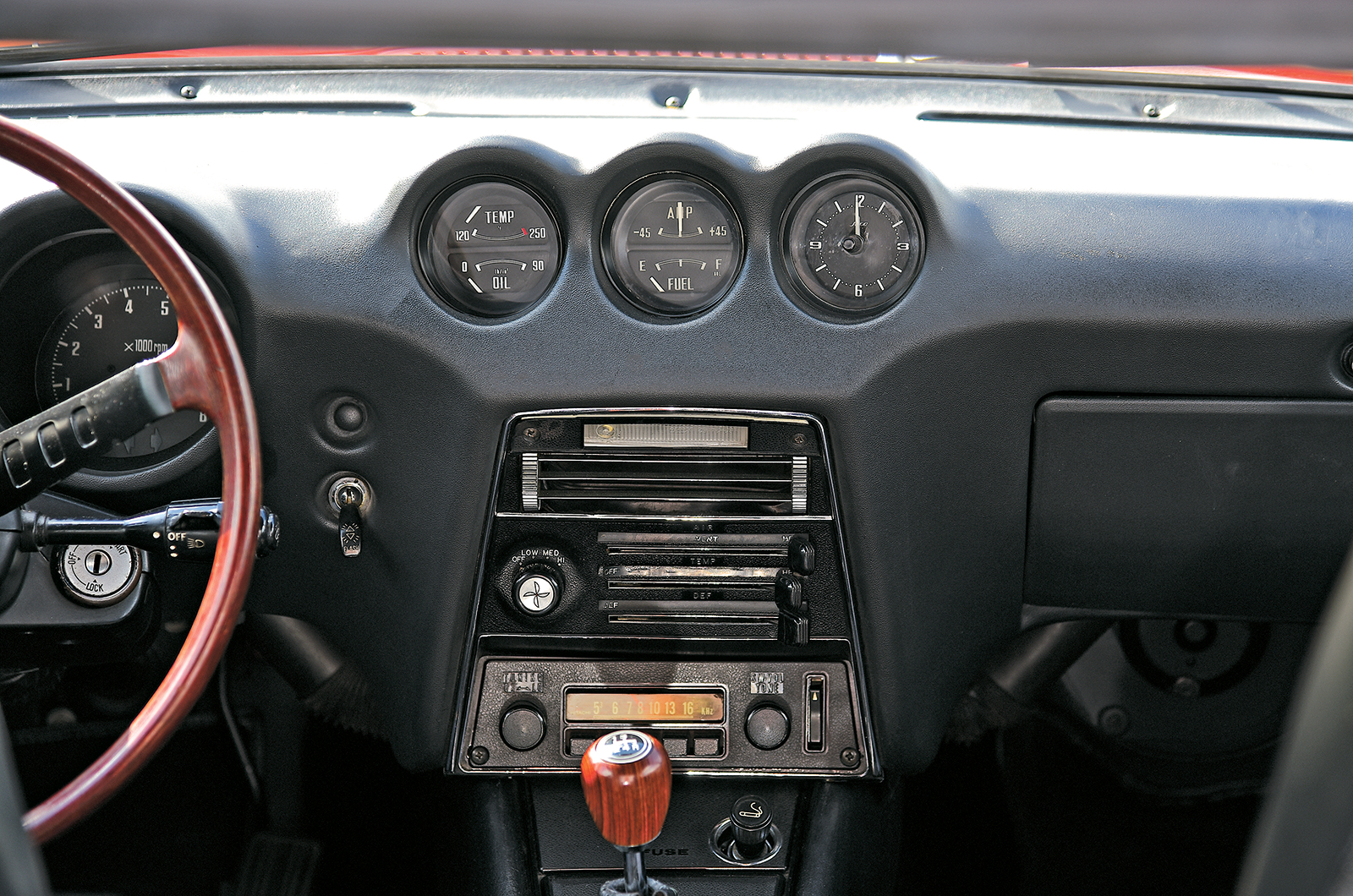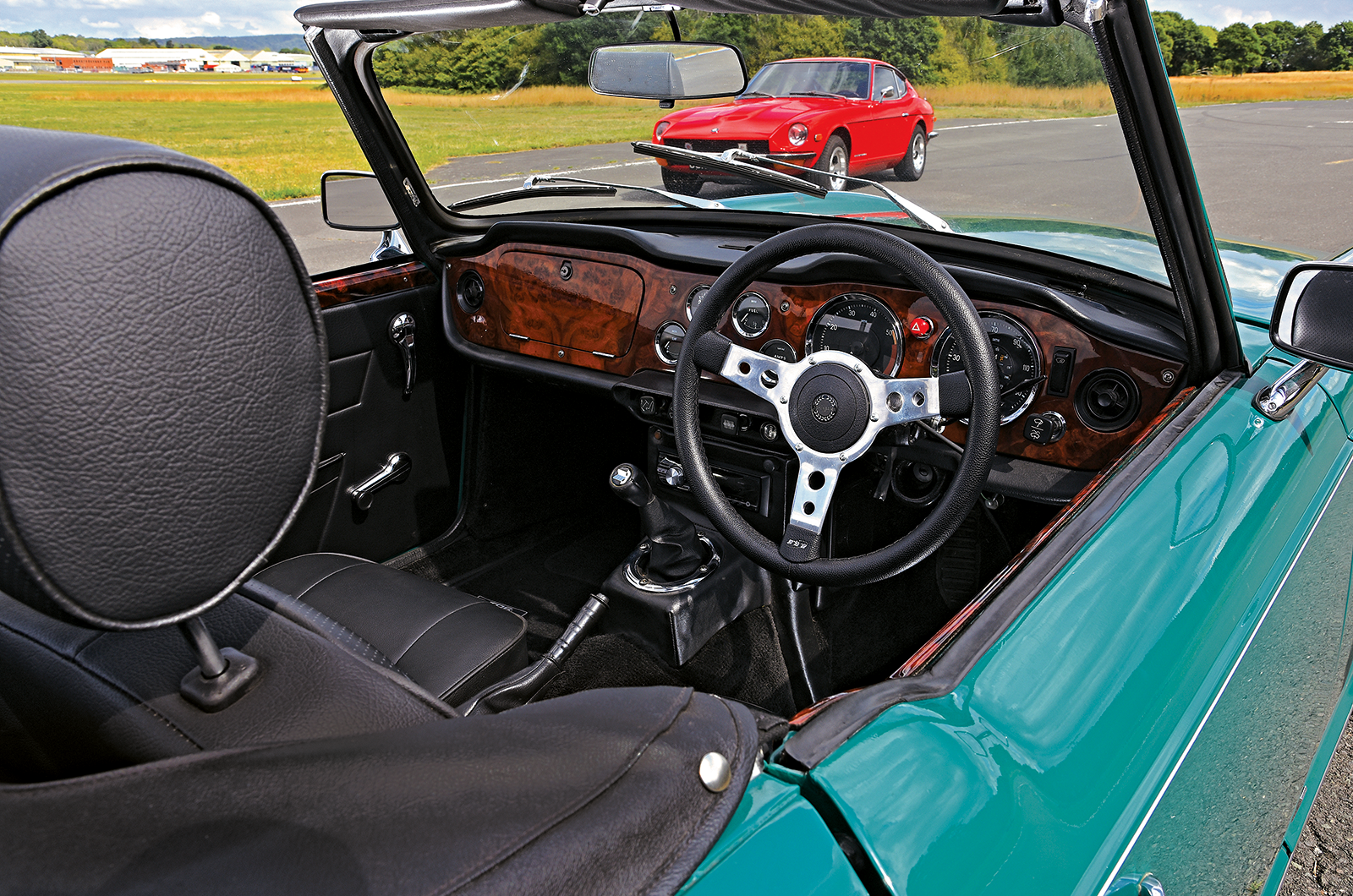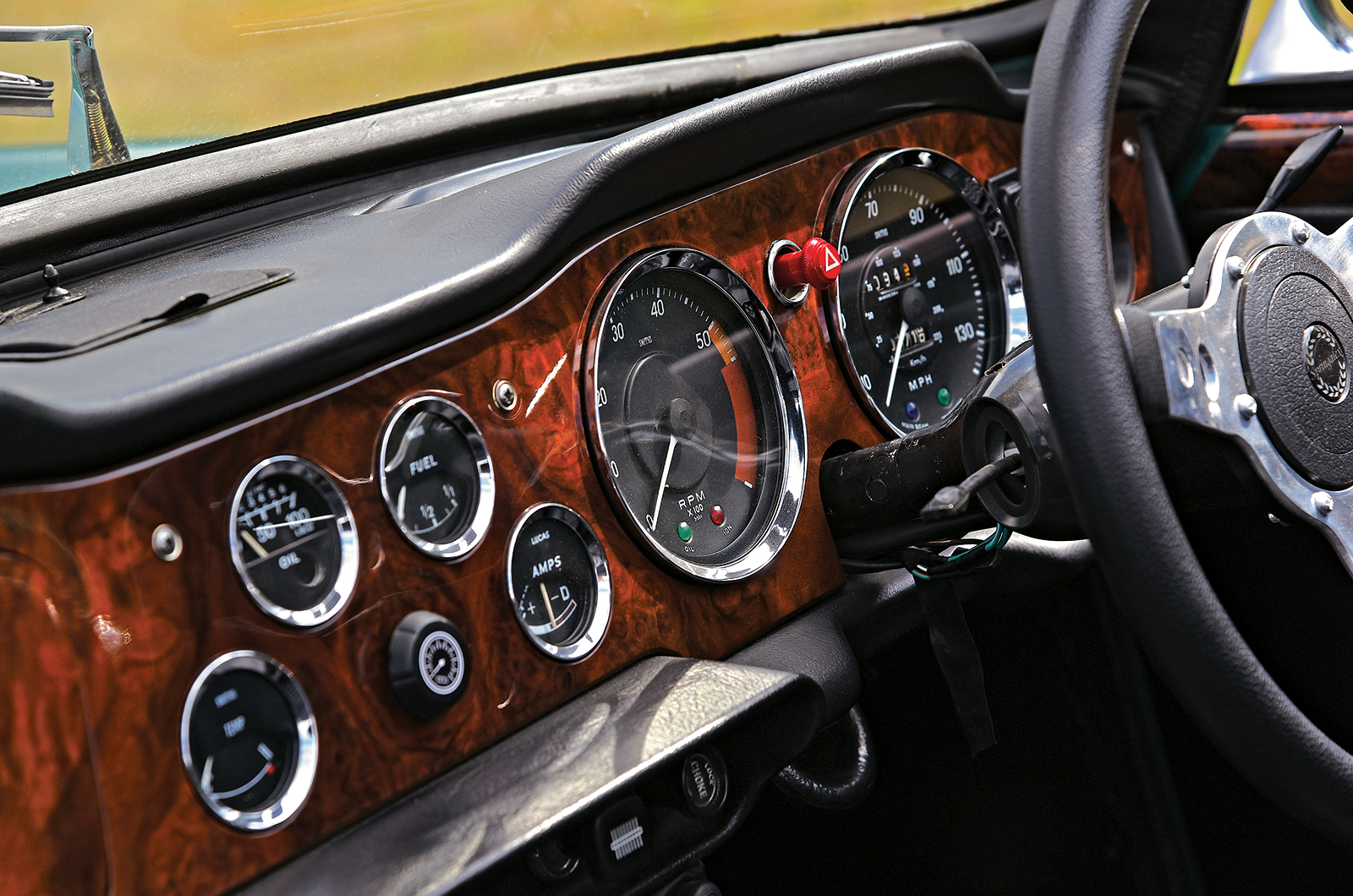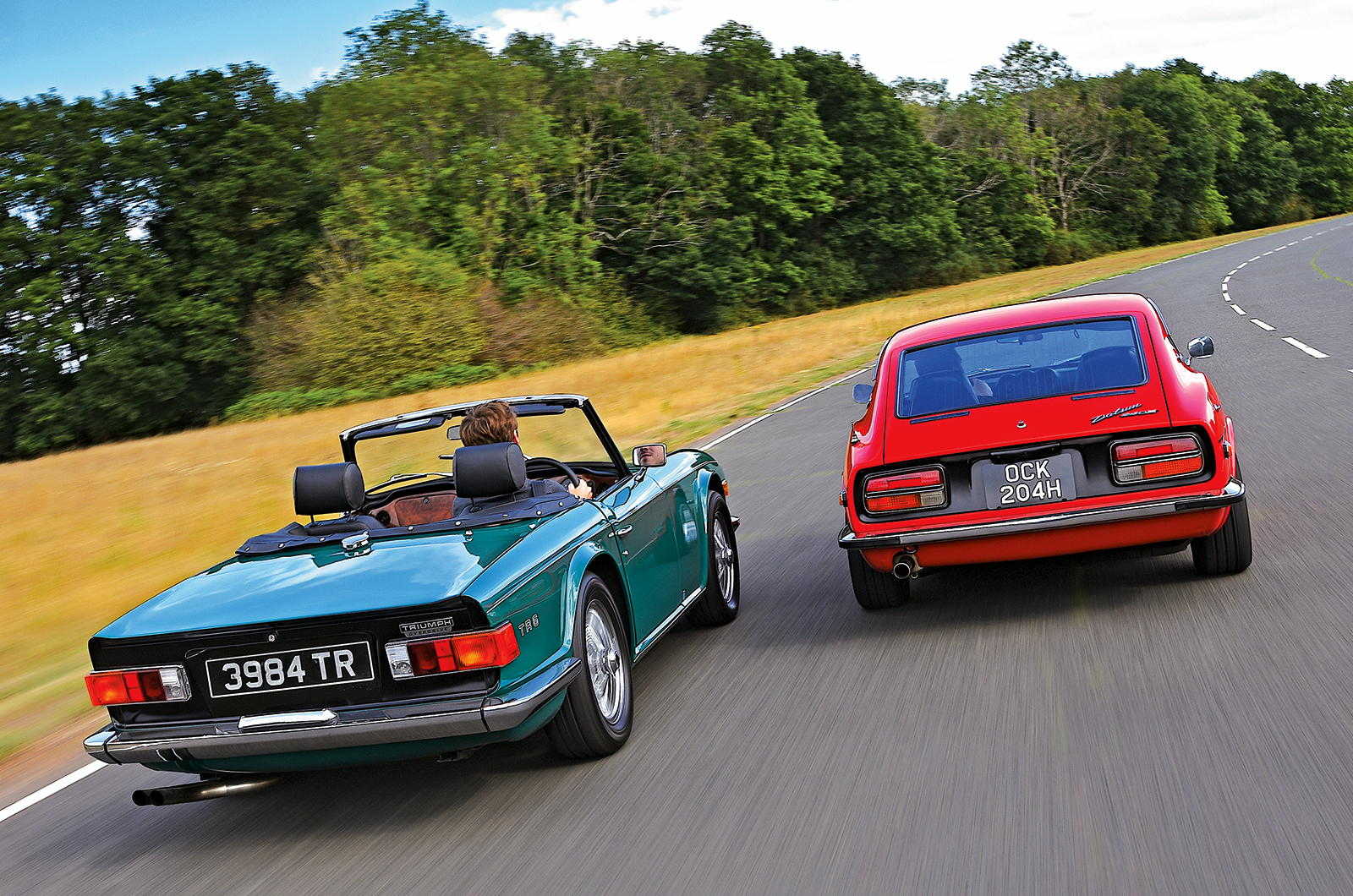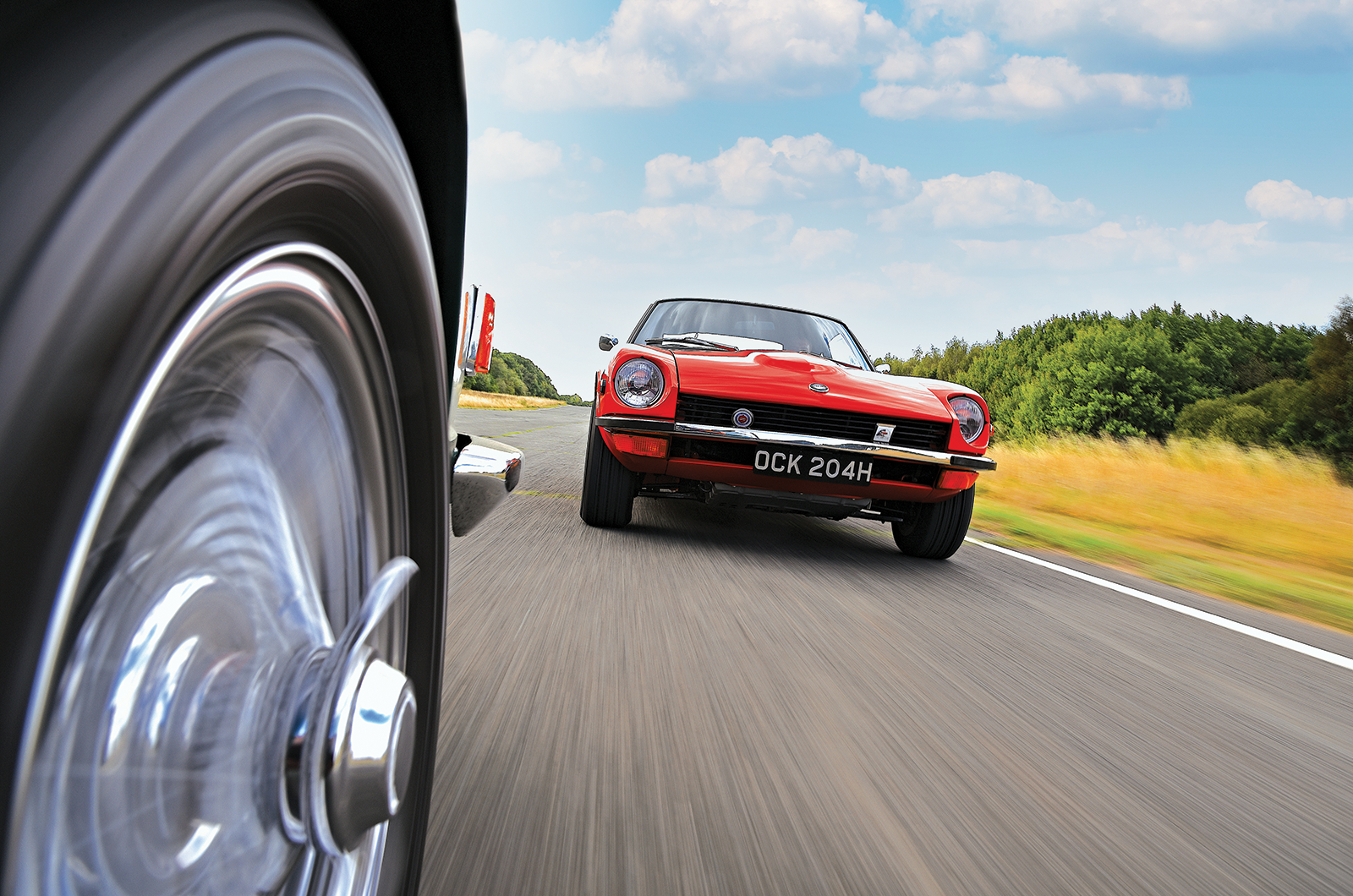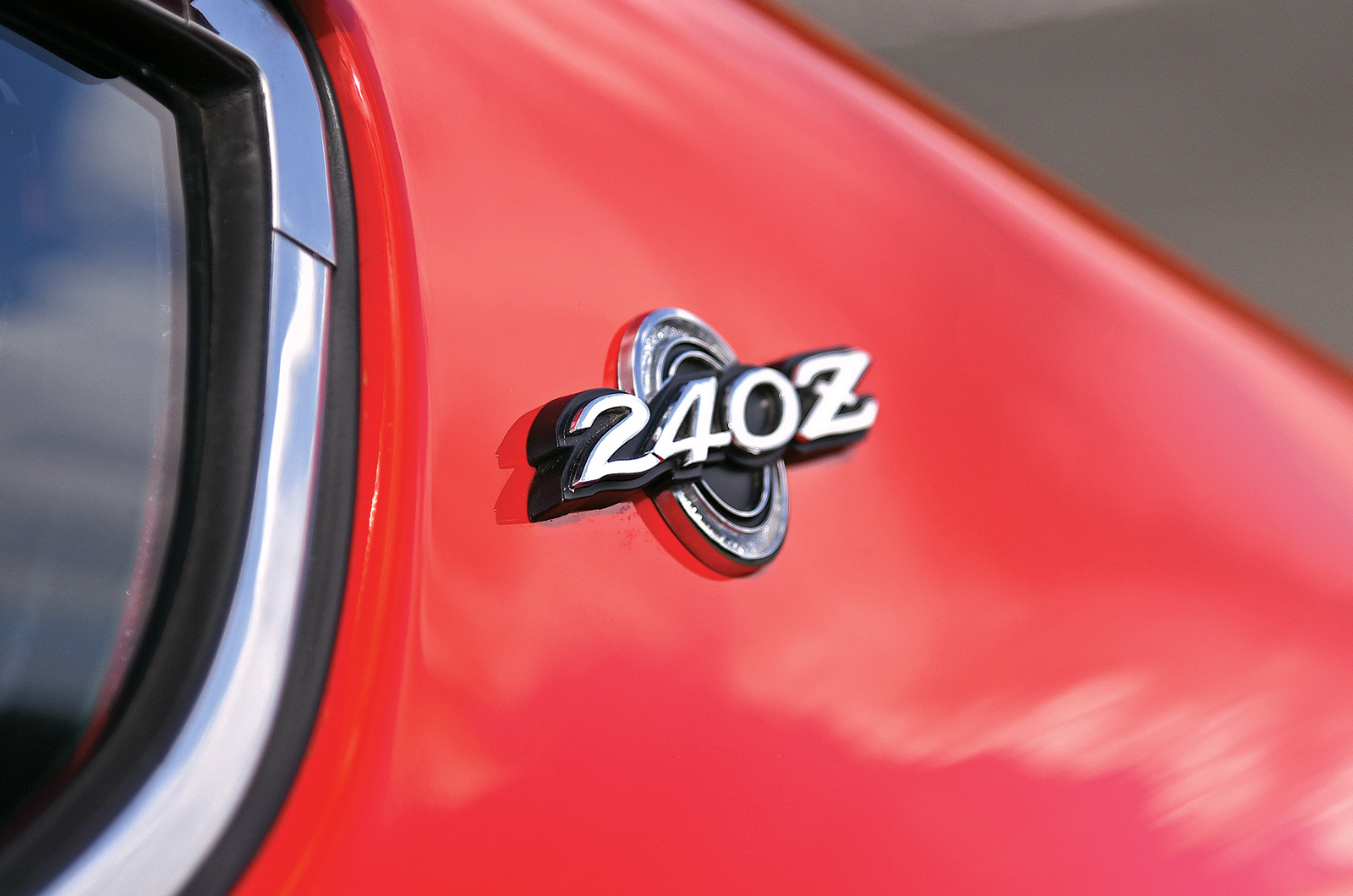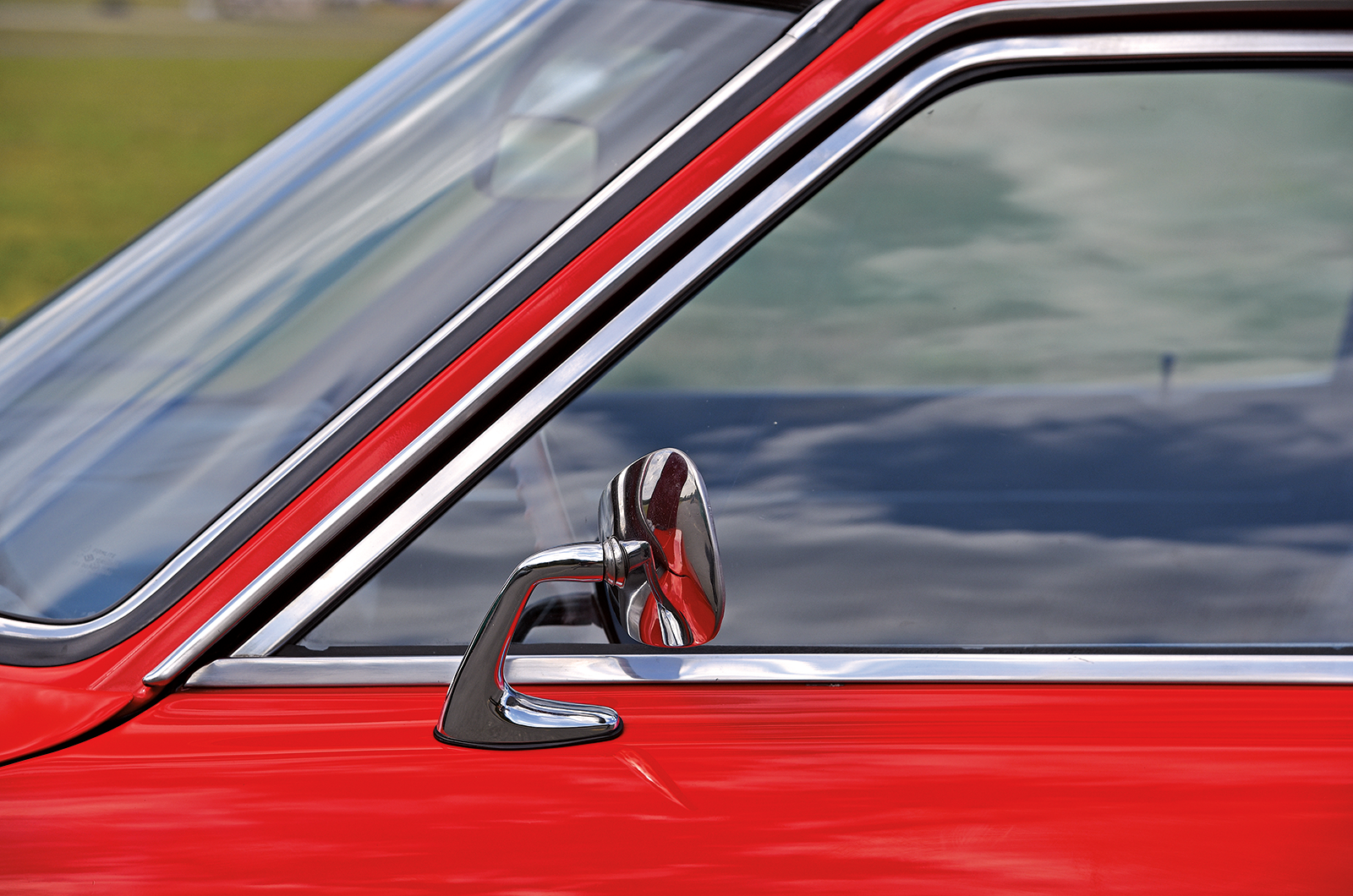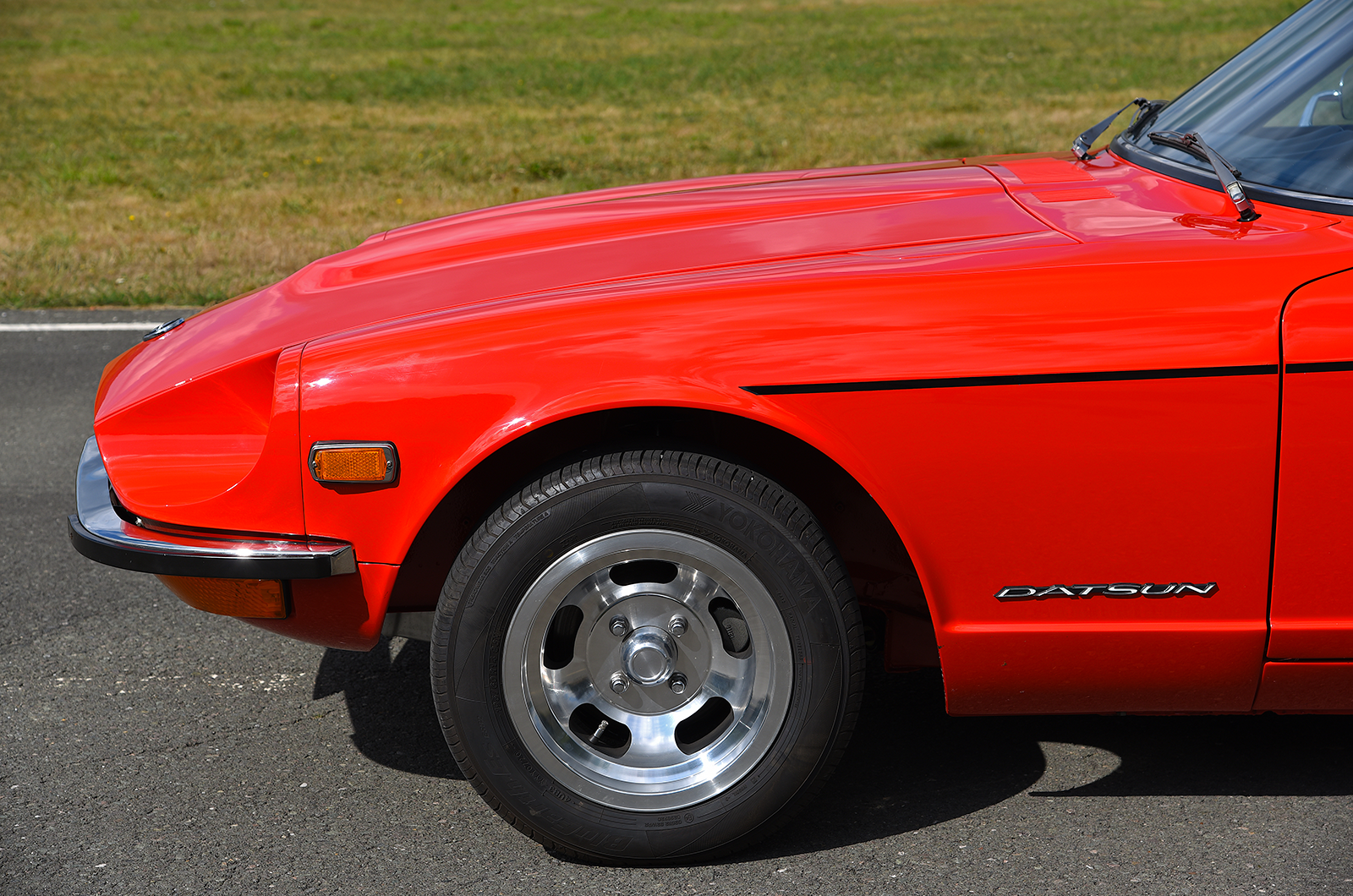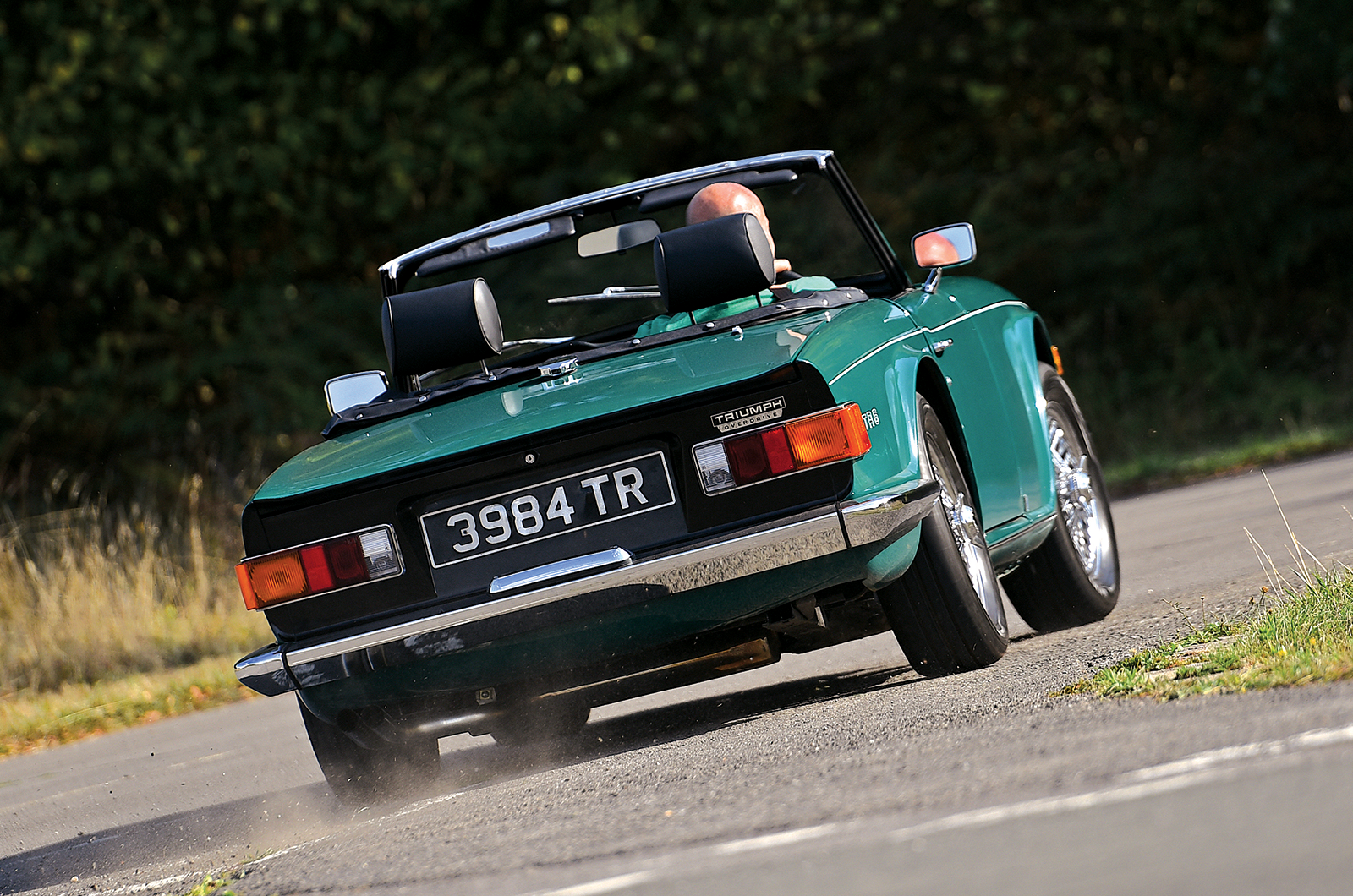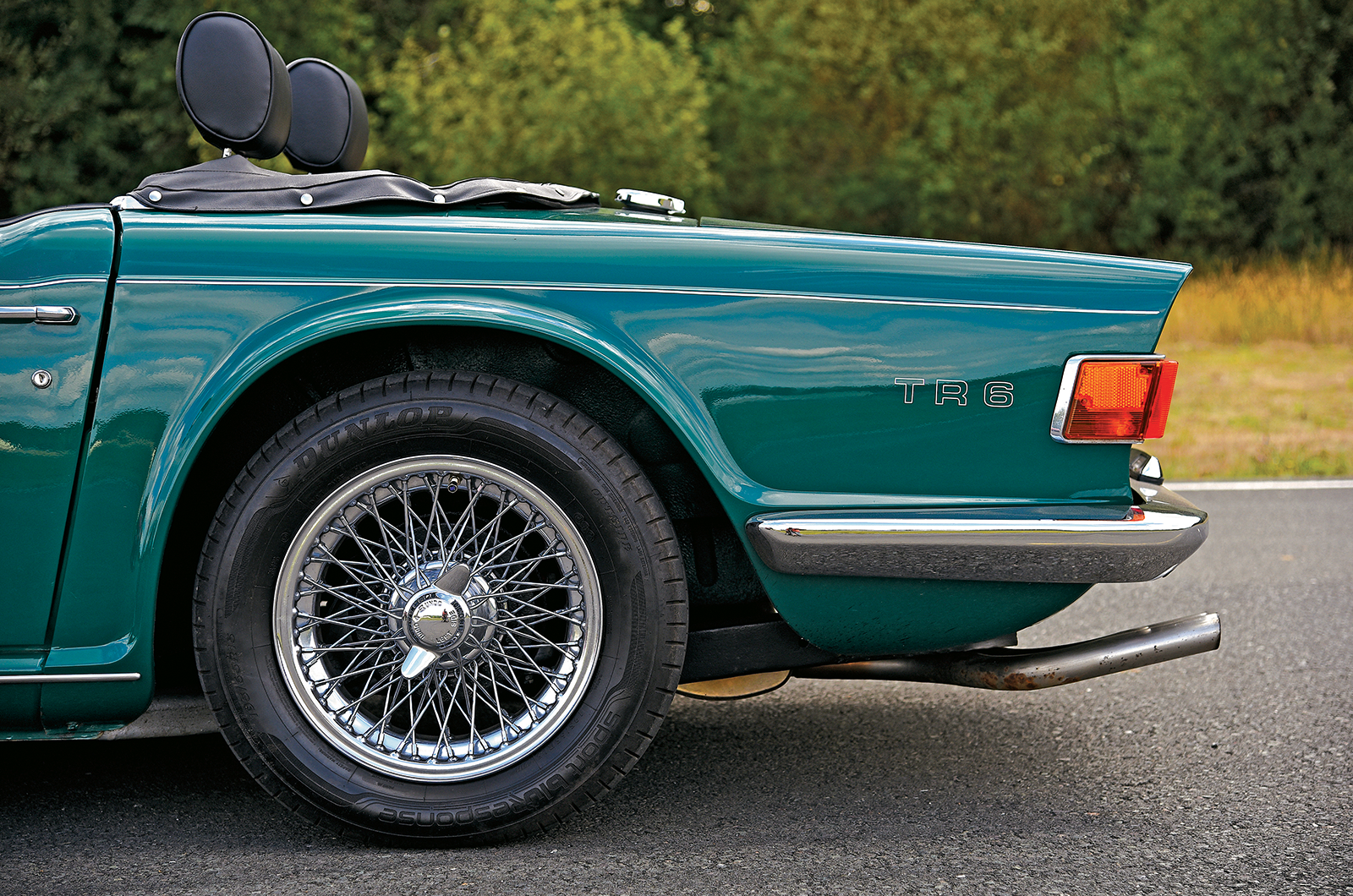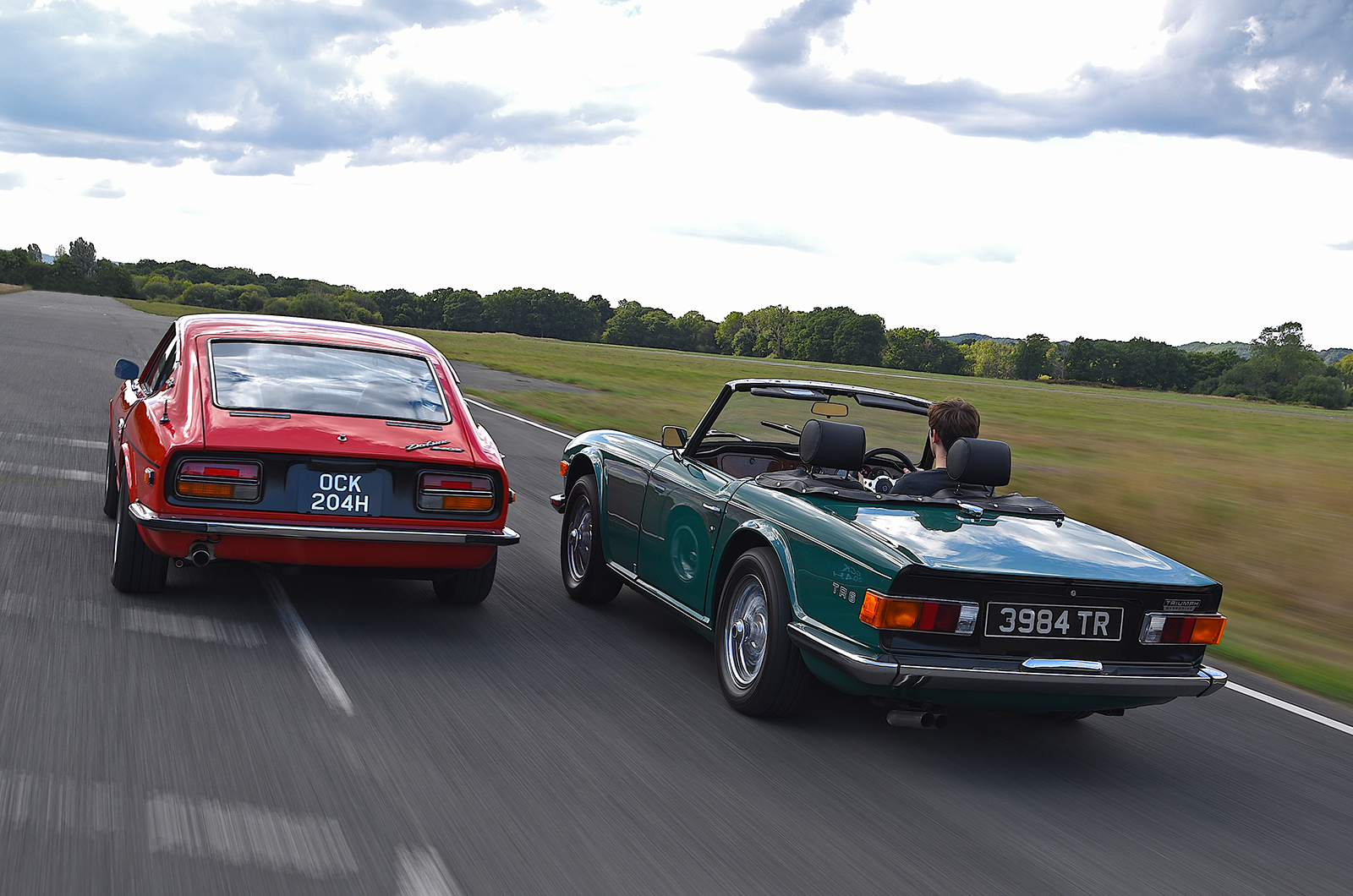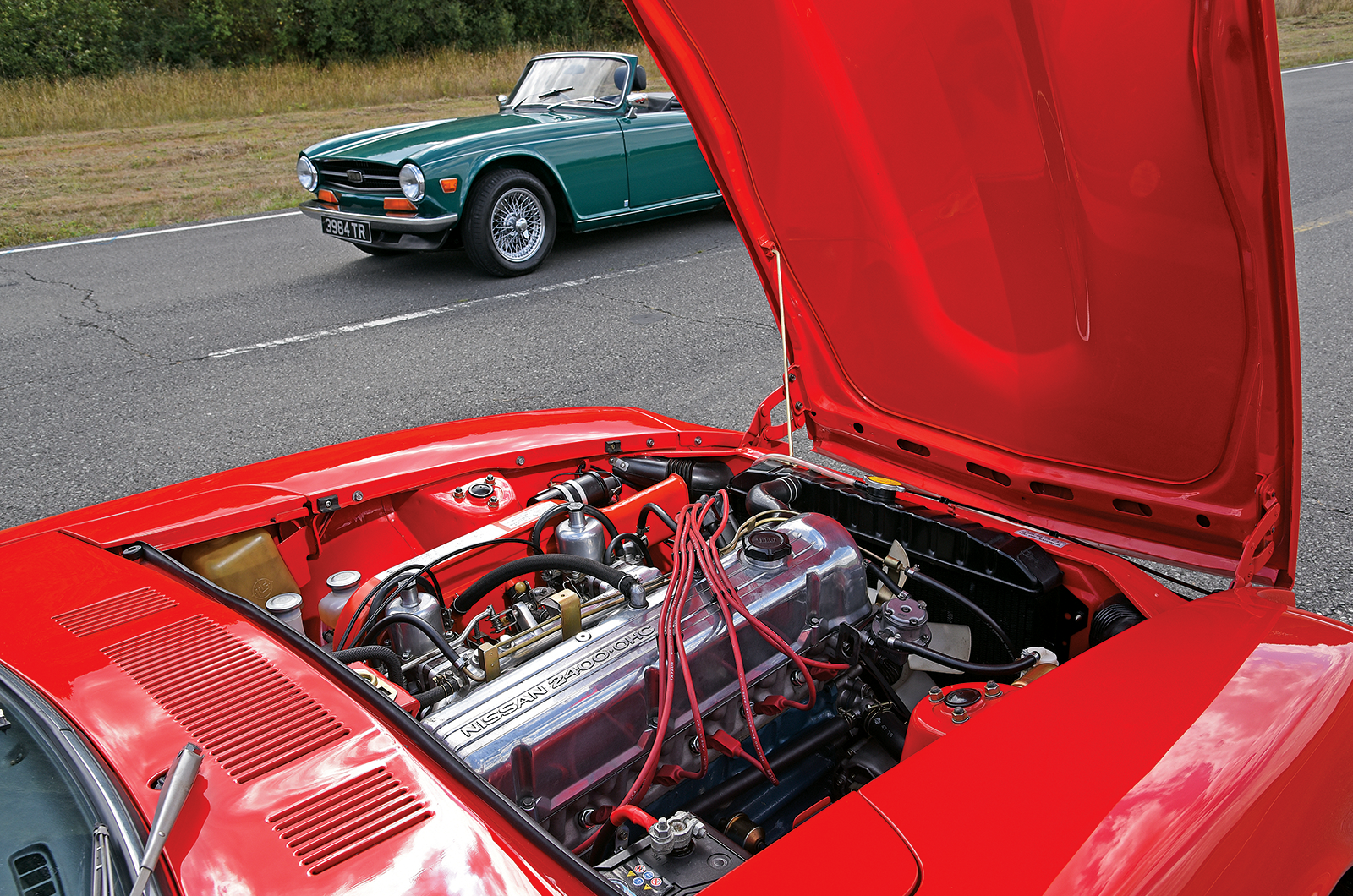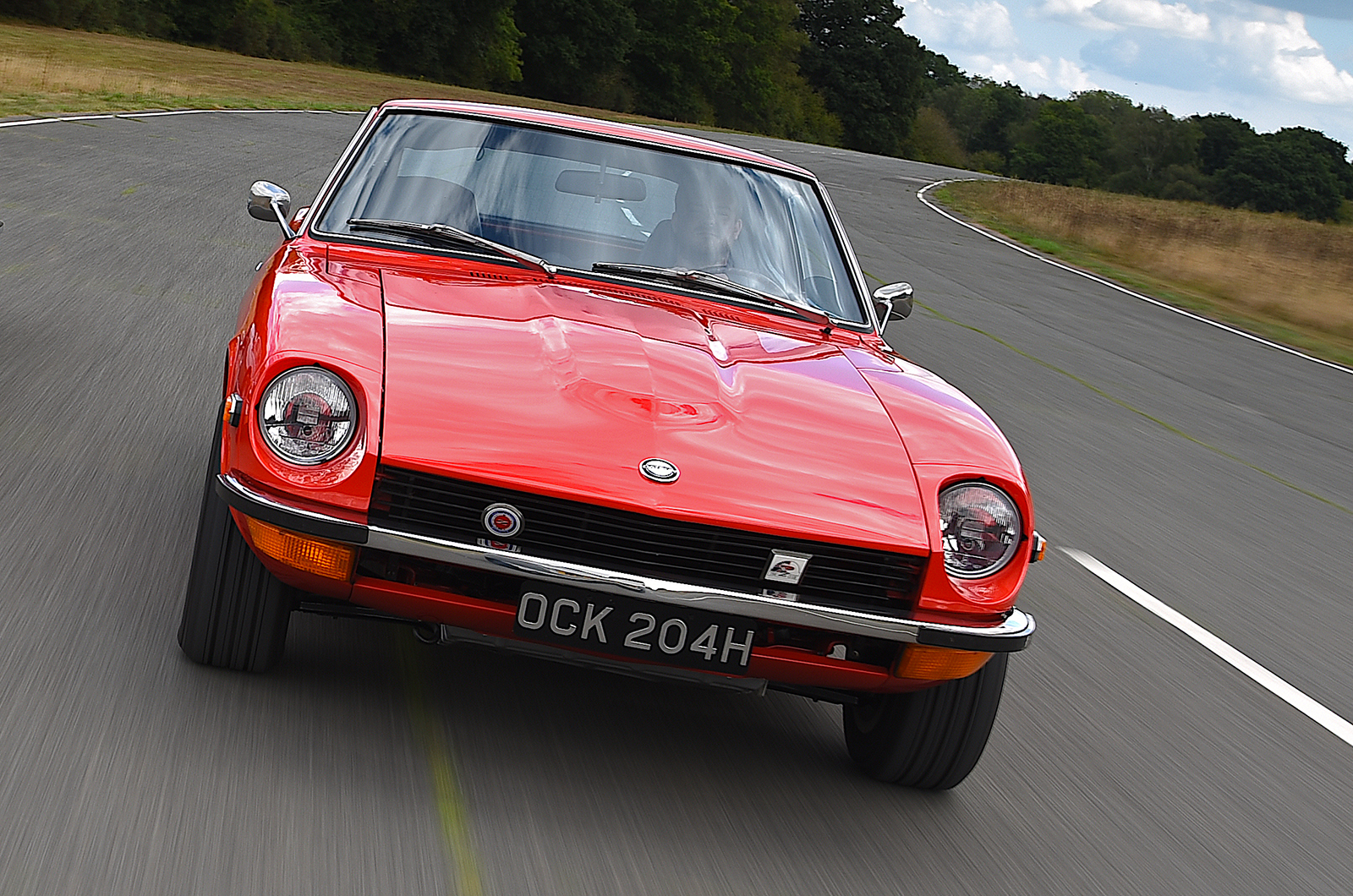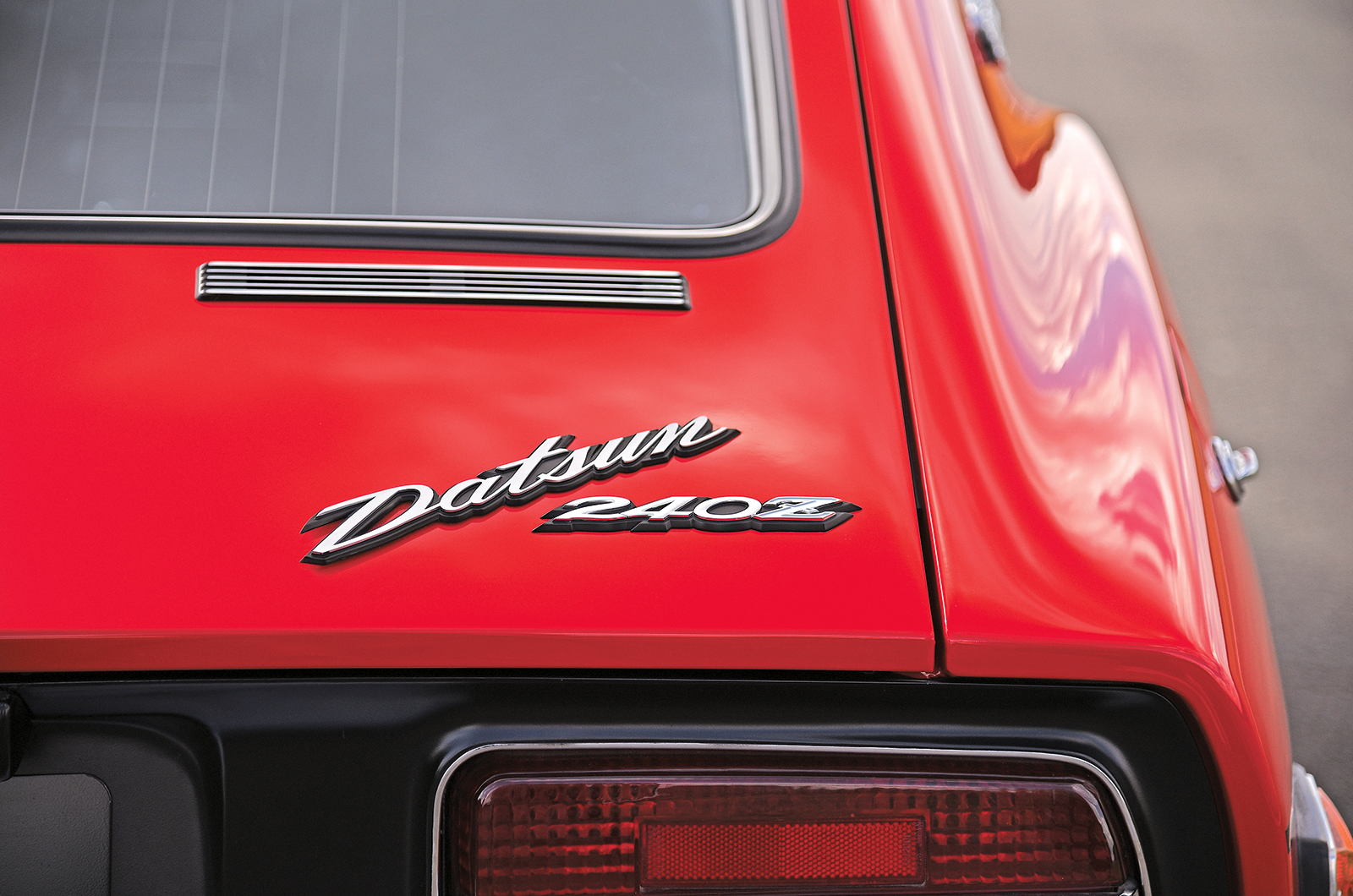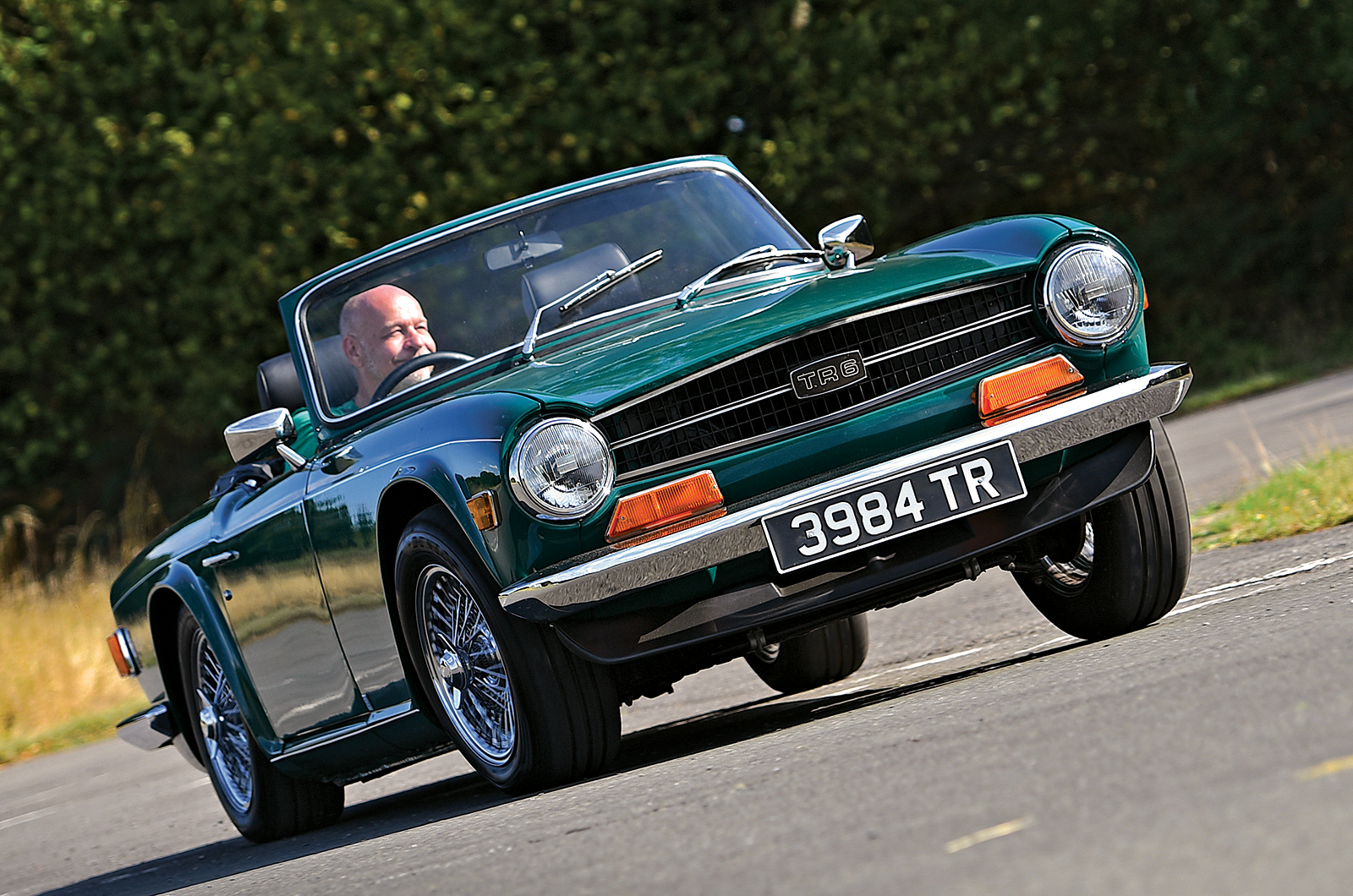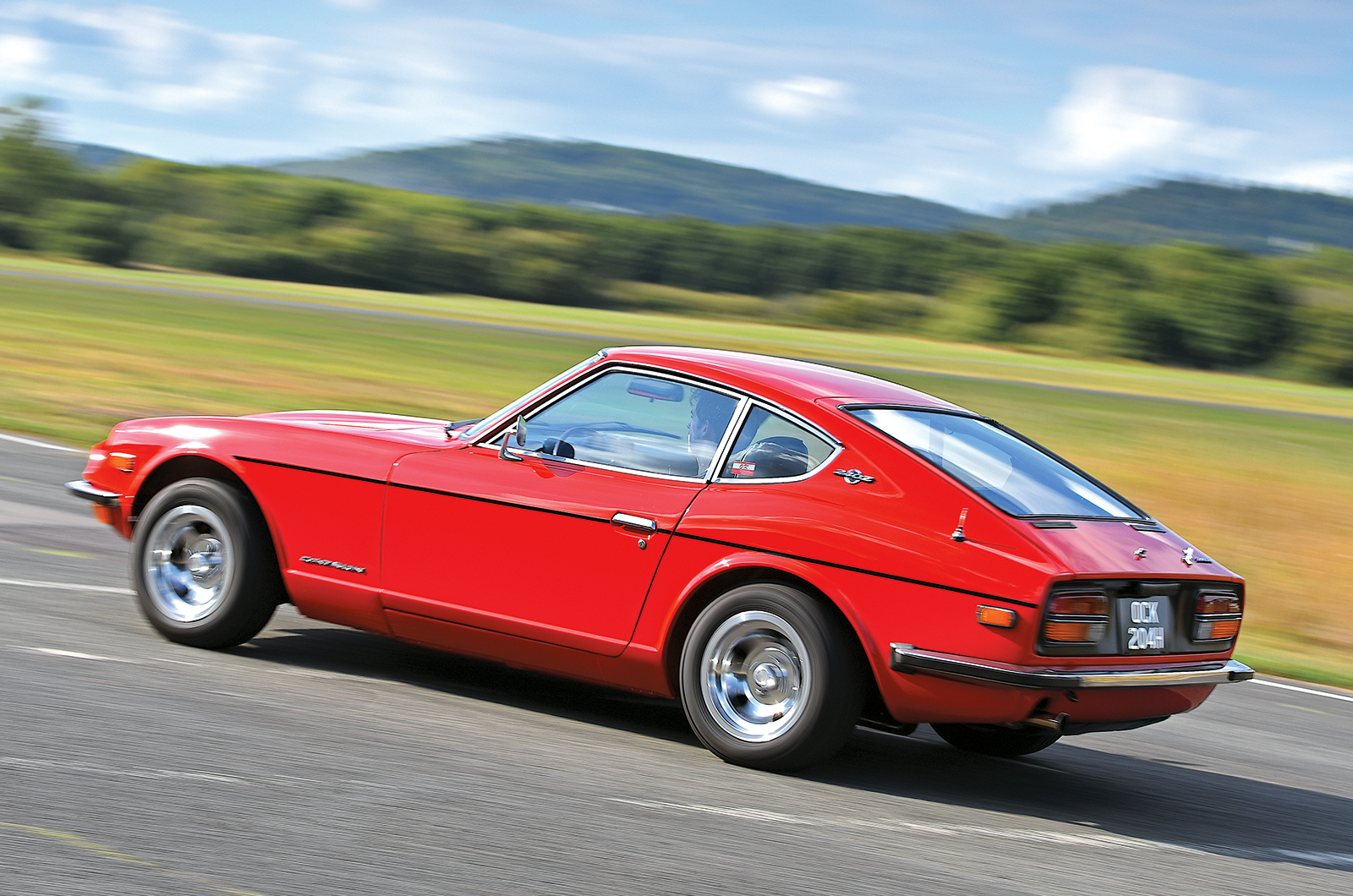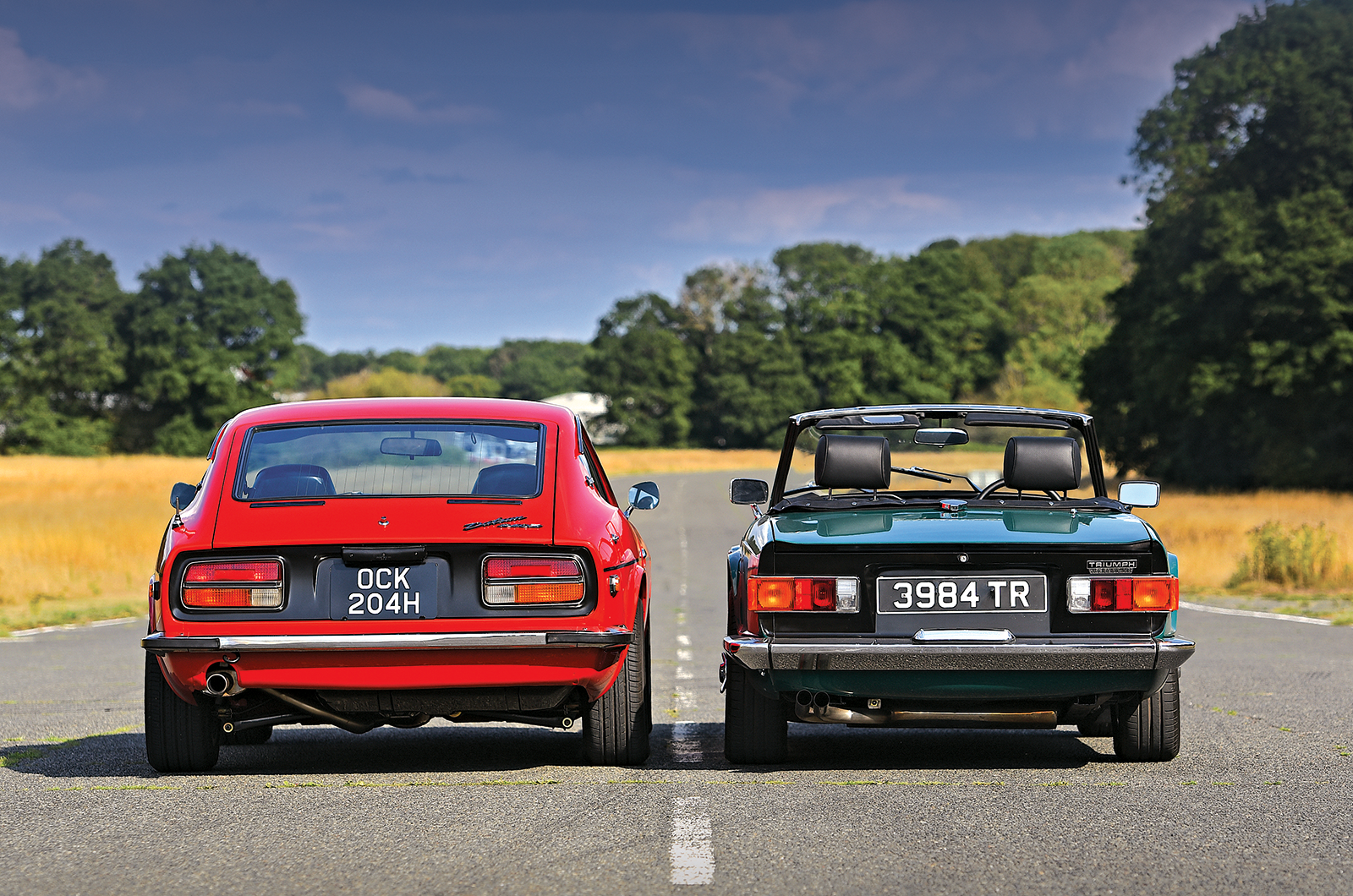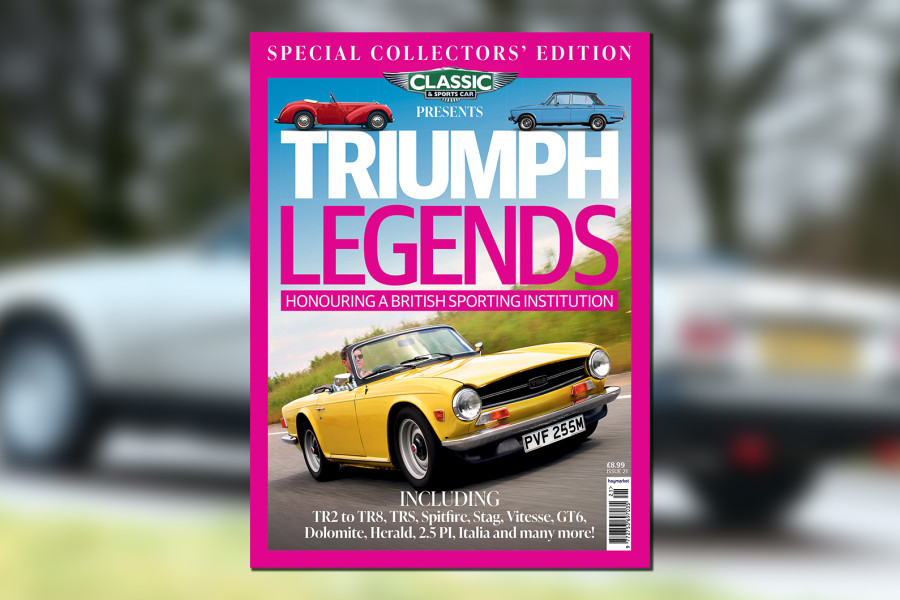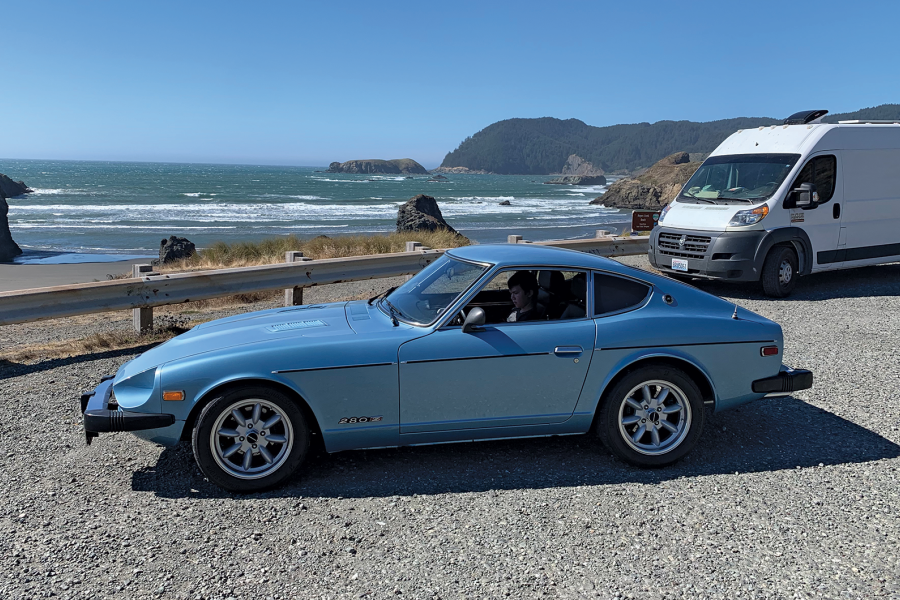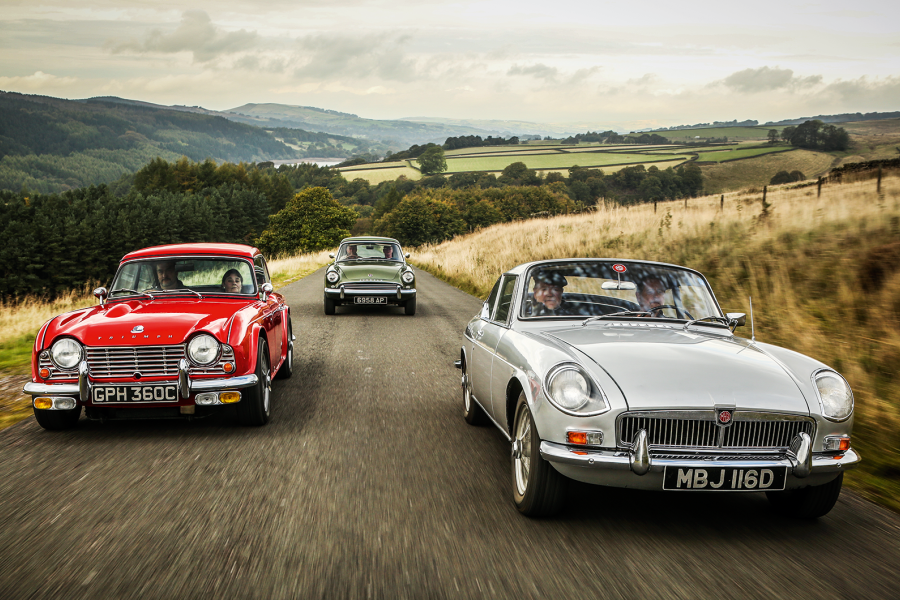A big part of these differing personalities lies in the car’s body styles.
The well-reported danger that the US might be planning to ban convertibles in the early 1970s no doubt swayed Datsun to make its new car a coupé rather than a drop-top, but it also adds to the Z’s refinement.
The roof eliminates wind noise and buffeting in the cabin, and makes the monocoque Datsun much stiffer.
The Triumph has a separate chassis, so doesn’t suffer scuttle shake in the modern idiom, but the body itself is always rattling on top of its frame, and never feels totally solid. Yet having a top robs the 240Z of the TR6’s extra degree of fun-factor.
The Triumph TR6’s 2.5-litre straight-six engine was carried over from its predecessor
Though both cars proved roaring success stories, each of those tales featured a very different ending.
Nissan has just released its seventh-generation Z model, albeit not for Europe, while Triumph struggled to maintain the TR6’s market share with its TR7 successor, and ceased to exist not long after that car’s demise.
The two models pictured here don’t just represent the handing over of the US sports car market from Britain to Japan, but also a generational shift in sports car expectations.
The 2.4-litre straight-six produces 151bhp in the Datsun and propels the car to 60mph in 8 secs
The Triumph is completely focused, built for sheer excitement, and its drawbacks wouldn’t have mattered to those seeking such old-school thrills.
The Datsun, in contrast, is for the kind of buyer who wants their sports car to do a bit of everything.
It’s more practical and flexible, yet no less of a driver’s car – and mustn’t be confused with its 1980s successors, which did undoubtedly lose some driver appeal in the pursuit of usability.
Yet its relative modernity next to the Triumph makes it more able to take on daily duties, and to tackle long drives.
The sweet-handling Datsun 240Z offers a more contemporary experience than the Triumph
Nowhere are their opposing characters more obvious than from within the cabins.
Datsun clearly decided to follow American trends, with styling that immediately puts you in mind of a C3 Corvette with its deeply cowled dials, steeply raked dashboard and central stack of black plastic – though the quality of the switchgear leaves you in no doubt this is a Japanese classic.
It’s not just American in appearance, but in operation, too, with proper ventilation controls, five interior vents, a well-located stereo and, behind them all, comfortable, full-sized seats.
The 240Z was a clean-sheet design
Though small by modern standards, the 240Z could still claim to be a ‘proper’ car to a 1970s American buying public, with a usable trunk to boot.
The Triumph is much more traditional, with just two eyeball vents in the timber dash (walnut on this car) that for many buyers would have been a point of pride over the Datsun’s soulless plastic.
The TR6 does major on that olde-worlde charm: beyond the wooden fascia there are the various licks of chrome on door furniture and instrument bezels, while its classic Smiths dials are real centrepieces, both clear and beautiful – and far prettier than the blocky gauges Triumph later adopted in a cost-saving move.
Extra side repeaters mark this out as an original US car, since converted to right-hand drive and UK specification
Little effort has been made in terms of ergonomics, however, and while the TR isn’t uncomfortably small, it is tight inside – especially for the elbows.
For all their obvious differences, both of these sports cars remain as compelling today as they were in period, but the fact that the TR6’s successor was a closed-cockpit coupé, with a moulded plastic dashboard, five-speed gearbox and much more relaxed road manners shows that even Triumph had seen which way the wind was blowing.
The 240Z’s greatest trick was not just showing that sports cars could be refined, reliable and comfortable, but that those things didn’t need to come at the expense of performance and fun.
Early Datsun 240Zs such as this have vents in the tailgate
On the billiard-table surface of a circuit, these two remain remarkably closely matched, but out in the real world there’s no doubt that the 240Z is the quicker car from point to point.
The adrenalin junkies who have kept cars in the mould of the TR6 popular long after they have gone out of mainstream production prove that this automotive cacophony still holds a unique appeal.
But the future was clear: since its demise, no large-volume manufacturer has built a car quite like the TR6, yet all of them – Triumph included – have strived to create an answer to the 240Z.
Images: Will Williams
Thanks to: Arun Ltd, 240Z owner Len Walsh and Fourways Engineering
Factfiles
Datsun 240Z
- Sold/number built 1969-’73/156,078
- Construction steel monocoque
- Engine iron-block, alloy-head, ohc 2393cc straight-six, twin Hitachi carburettors
- Max power 151bhp @ 5600rpm
- Max torque 146lb ft @ 4400rpm
- Transmission five-speed manual, RWD
- Suspension independent, at front by MacPherson struts, anti-roll bar rear MacPherson struts
- Steering rack and pinion
- Brakes discs front, drums rear, with servo
- Length 13ft 7in (4140mm)
- Width 5ft 4in (1625mm)
- Height 4ft 2½in (1283mm)
- Wheelbase 7ft 6in (2299mm)
- Weight 2284lb (1038kg)
- 0-60mph 8 secs
- Top speed 125mph
- Mpg 24
- Price new £2288 (1971)
- Price now £20-50,000*
Triumph TR6
- Sold/number built 1969-’76/94,619
- Construction steel chassis, steel body
- Engine all-iron, ohv 2498cc straight-six, Lucas mechanical fuel injection
- Max power 150bhp @ 5500rpm
- Max torque 164lb ft @ 3500rpm
- Transmission four-speed manual with overdrive, RWD
- Suspension independent, at front by wishbones, telescopic dampers, anti-roll bar rear semi-trailing arms, lever-arm dampers; coil springs f/r
- Steering rack and pinion
- Brakes discs front, drums rear, with servo
- Length 12ft 11½in (3949mm)
- Width 5ft 1in (1549mm)
- Height 4ft 2in (1270mm)
- Wheelbase 7ft 4in (2235mm)
- Weight 2473lb (1122kg)
- 0-60mph 8.2 secs
- Top speed 119mph
- Mpg 18
- Price new £1536 (1971)
- Price now £15-30,000*
*Prices correct at date of original publication
Enjoy more of the world’s best classic car content every month when you subscribe to C&SC – get our latest deals here
READ MORE
Datsun 240Z: Nissan’s new broom
Triumph tussle: TR5 vs TR6
Buyer’s guide: Datsun 240Z/260Z
Your classic: Triumph TR4A
Charlie Calderwood
Charlie Calderwood is Classic & Sports Car’s Features Editor
